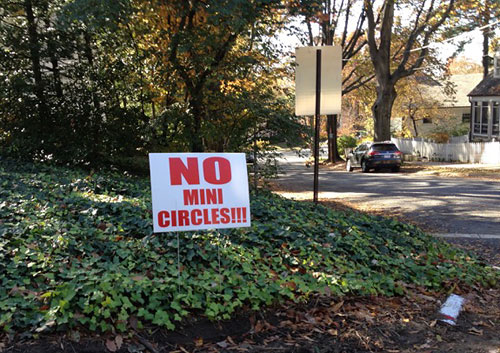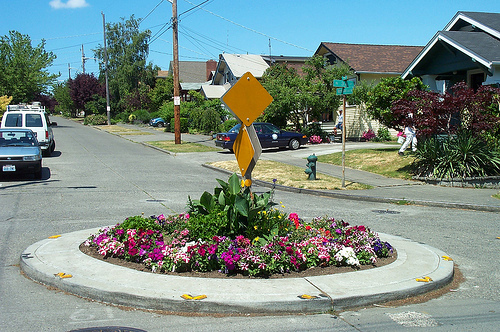Mini-circles calm traffic in AU Park but stir opposition
For a year now, drivers and cyclists on 42nd Street NW encountered a traffic calming device that’s new to DC: Small traffic circles made out of plastic pylons. Permanent versions will soon replace them. But not all neighbors are pleased.

42nd Street is a popular route through American University Park. It offers a way to reach homes, schools, and a senior center without using busy Wisconsin Avenue. But drivers speed through the area and it was not safe enough for pedestrians, a 2011 study of the area found.
The solution? Mini-circles, a traffic calming device that’s common in places such as Seattle, Portland, and Palo Alto, California. These provide a more pleasurable way to slow traffic than a speed bump. They are more effective than stop signs, since drivers may ignore a sign but must slow down to navigate the circle.
On 42nd Street, DDOT installed two mini-roundabouts a year ago to slow cars but keep the road working as a through route. Warren Street splits a block to the west and meets 42nd in two separate curved intersections where drivers take the turns too fast and often blindly.
American University agreed to pay for the traffic calming as part of negotiations over its most recent campus plan. That will fund more permanent versions, whose construction is scheduled to start on November 19.
Some neighbors say no
When the circles first appeared, some drivers complained of being confused. Sherry Cohen, a resident, said she thought the circles were dangerous.
The data, at least in Seattle, says otherwise: A 1997 study found that crashes dropped 94 percent in areas that got mini-circles. The city found that, “In addition to reducing [crashes], traffic circles have been effective at reducing vehicle speeds but have not significantly reduced traffic volumes.”
Recently, Joan Silver, who lives right at the corner of 42nd and Warren, started circulating a petition opposing the permanent circles. She wants a new study to consider instead using stop signs or speed bumps.

Silver complains that the circles “do not satisfactorily or adequately address the range of traffic-related safety issues at the specified location, and … have generated a number of dangerous conditions in their own right and negative impacts on properties immediately surrounding them.”
Matthew Frumin, who chairs the area’s Advisory Neighborhood Commission (3E), canvassed the neighborhood after receiving the complaints. In an email to the other commissioners and some of the petitioners, Frumin said that neighbors around the northern circle strongly favored making it permanent.
“While they do not think the circles are the only possible solution, they believe even the temporary northern circle has improved traffic conditions considerably,” he wrote, “and that in the next phase when the circle takes its new shape and the crosswalk is added, conditions will improve further. If there is not a unanimous consensus around that, there is a very strong and decisive one in favor of the circle.” Residents around the southern circle had more mixed views.
Comments on the petition say that the circles confuse some drivers (who even may go around the wrong way) or cause backups. Others complain that the pylons are ugly.
The permanent circles should address the aesthetic complaints. They will have landscaping that will create an attractive focal point for the residential neighborhood.
And fewer drivers will be “confused” as they get used to the circles. In other cities, drivers have not found them confusing or have adjusted. Perhaps a sign could help; some circles have them, though signs are also less attractive.
Trying new designs that have worked elsewhere should be the norm for our neighborhood streets. Hopefully DDOT will continue to experiment with ways to slow traffic down and make streets safer and more pleasant for everyone.

